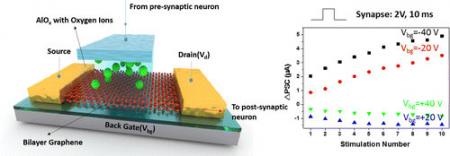Researchers at Tsinghua University, China, have created an artificial synapse out of aluminum oxide and twisted bilayer graphene. By applying different electric voltages to the system, they found they could control the reaction intensity of the receiving neuron. The team says their novel dynamic system could aid in the development of biology-inspired electronics capable of learning and self-healing.

In recent years, researchers have been building artificial neurons and synapses with some success but without the flexibility needed for learning. However, this first-of-its-kind synthetic synapse mimics the plasticity of the brain, bringing science one step closer to human-like artificial intelligence.
Source: nanowerk via nanoletters
Posted: Nov 12,2015 by Roni Peleg